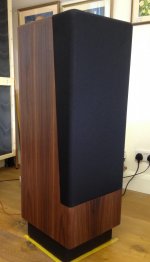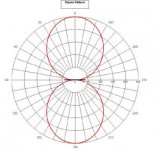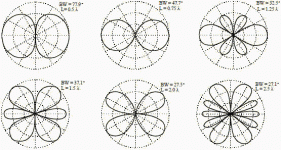After much reading i have built Troels Gravesens Fusion BAD. (pic attached) Why, because he seems to go into every detail and explanation and builds for big companies as well and then gives out free build information. i liked that style.
I think they are great, i think he has done a great job and service, i am listening now, everyone else who has listened says how "out of the box" the sound is, its dynamic, realistic, great bass etc etc.
Its the best sound i have ever heard, but i accept completely there is better to be had, even Troels' own more advanced designs, probably much of what all you guys build.
I have also now read lots more since i built these.
I have done quite a lot to the room, that has helped a lot as well.
I am not dissatisfied at all, more curious, everyone says Open Baffle blow boxes away, so, if i used exactly the same hardware on an open baffle would it be interesting and good, or a waste of time and effort. the baffle could be the same dimensions, i can use the passive crossover i already built for mid/treble and even adjust the bass if necessary as the design has DSP plate amps on the bass....
It may just be that lockdown causes this curiosity, is it worth a project or a waste of time!?
thanks mike
I think they are great, i think he has done a great job and service, i am listening now, everyone else who has listened says how "out of the box" the sound is, its dynamic, realistic, great bass etc etc.
Its the best sound i have ever heard, but i accept completely there is better to be had, even Troels' own more advanced designs, probably much of what all you guys build.
I have also now read lots more since i built these.
I have done quite a lot to the room, that has helped a lot as well.
I am not dissatisfied at all, more curious, everyone says Open Baffle blow boxes away, so, if i used exactly the same hardware on an open baffle would it be interesting and good, or a waste of time and effort. the baffle could be the same dimensions, i can use the passive crossover i already built for mid/treble and even adjust the bass if necessary as the design has DSP plate amps on the bass....
It may just be that lockdown causes this curiosity, is it worth a project or a waste of time!?
thanks mike
Attachments
Hi, I think it's in the sticky threads but, no, it isn't.
It's about OB, OB theory at first page, and it says:
Choose a big woofer. Why? because there's a lot of acoustic short circuit.
So, no ( generally no), your actual woofer won't do.
What about the mid-treble section? Compare the sensitivity of the mid-tr section to a woofer candidate and see where they meet, at least at 100 Hz.
I doubt a 15" could make it, maybe two - as you may usually see in many OB designs.
So the route is usually big pro woofers...for passive
Edit: On the contrary, big woofers with little magnet, not the 500 W monster, are said to work well, dunno if it's for high or low Qts 😛
It's about OB, OB theory at first page, and it says:
Choose a big woofer. Why? because there's a lot of acoustic short circuit.
So, no ( generally no), your actual woofer won't do.
What about the mid-treble section? Compare the sensitivity of the mid-tr section to a woofer candidate and see where they meet, at least at 100 Hz.
I doubt a 15" could make it, maybe two - as you may usually see in many OB designs.
So the route is usually big pro woofers...for passive
Edit: On the contrary, big woofers with little magnet, not the 500 W monster, are said to work well, dunno if it's for high or low Qts 😛
Last edited:
Another approach is dipole.
In any case, the best speaker design depends upon the application and the space. But I would say that, given adequate space, a dipole is great for a home system. Siegfried Linkwitz's system was easily the best home system I've ever heard.
This is partly because of room acoustics.
In any case, the best speaker design depends upon the application and the space. But I would say that, given adequate space, a dipole is great for a home system. Siegfried Linkwitz's system was easily the best home system I've ever heard.
This is partly because of room acoustics.
Hi, I think it's in the sticky threads but, no, it isn't.
It's about OB, OB theory at first page, and it says:
Choose a big woofer. Why? because there's a lot of acoustic short circuit.
So, no ( generally no), your actual woofer won't do.
What about the mid-treble section? Compare the sensitivity of the mid-tr section to a woofer candidate and see where they meet, at least at 100 Hz.
I doubt a 15" could make it, maybe two - as you may usually see in many OB designs.
So the route is usually big pro woofers...for passive
Edit: On the contrary, big woofers with little magnet, not the 500 W monster, are said to work well, dunno if it's for high or low Qts 😛
thanks already gents, it will be an intriguing read, so where does the magic come from the bass on OB or the mid/treble, or is it all or nothing!?
You may find this video helpful. Got to get past the fact that he is selling things of course, but the basics are solid.
YouTube
Many thanks, intriguing video
Having done an hours reading i conclude my original question is obviously a silly idea! - everything needs to be different for an OB
Whether i might eventually look at building OB will i sense be a long thought process, lots of reading etc,
thanks to all
Just a quick FWIW that the reason people say OBs avoid the "boxy" sound is because their boxes were inadequately braced in the first place. A well-designed box won't contribute to the sound.
Chris
Chris
Just a quick FWIW that the reason people say OBs avoid the "boxy" sound is because their boxes were inadequately braced in the first place. A well-designed box won't contribute to the sound.
Chris
Many thanks Chris, IMHO all Troels Gravesen designs would fall under the description well designed, and as previously noted, i think they are great, here is a link to his page FUSION-BI-AMP/DSP
However, he has also done some OB designs and echos the view about openness/transparency at least to some extent.
I dont think the Fusion sounds boxy, in fact the opposite, but i have never heard OB and thought it worth asking the question, and of course now i am not so sure!
You can build a simple OB to see if you like the sound and can accommodate one in your room. Linkwitz's site shows the evolution of his dipole designs. People don't always mean dipole when they say OB.Having done an hours reading i conclude my original question is obviously a silly idea! - everything needs to be different for an OB
Whether i might eventually look at building OB will i sense be a long thought process, lots of reading etc,
thanks to all
Those drivers could be used dipole, the original Orion was a forward firing tweeter crossed to an 8" woofer at 1.6K, the 12n630 would be struggling to keep up though. The mid is also worked hard and the 18m is not a very big driver.
Dipole bass needs more volume displacement than a closed box to get to the same spl particularly as frequency goes below 50Hz.
Your speaker looks really nice I would leave these as they are, or if you really wanted to try use the mid and tweeter dipole with the woofer closed.
What type of music do you listen to? This matters because dipoles need to be in the right room and right position to work well and even then they are much more suited to acoustic and orchestral music. When things get heavy, distorted and aggressive they don't sound that great to me.
I have built the original Orion and LX521 systems and had them for quite a long time. I don't own them anymore as my musical tastes don't suit them.
It makes intuitive sense that an open baffle speaker will sound more open and less boxy, unfortunately it is not the reality. They can sound great but so can boxes when designed correctly.
Dipole bass needs more volume displacement than a closed box to get to the same spl particularly as frequency goes below 50Hz.
Your speaker looks really nice I would leave these as they are, or if you really wanted to try use the mid and tweeter dipole with the woofer closed.
What type of music do you listen to? This matters because dipoles need to be in the right room and right position to work well and even then they are much more suited to acoustic and orchestral music. When things get heavy, distorted and aggressive they don't sound that great to me.
I have built the original Orion and LX521 systems and had them for quite a long time. I don't own them anymore as my musical tastes don't suit them.
It makes intuitive sense that an open baffle speaker will sound more open and less boxy, unfortunately it is not the reality. They can sound great but so can boxes when designed correctly.
You can build a simple OB to see if you like the sound and can accommodate one in your room. Linkwitz's site shows the evolution of his dipole designs. People don't always mean dipole when they say OB.
The difference between simple OB and dipole already eludes me, more reading necessary. One of the reasons i definitely will not reach any conclusions easily or quickly, trouble is, the very reason we are all on the diy forum is its fun to try!
My first experiment with OB was coaxial car speakers and a cardboard baffle. True dipole over the audio range is hard to achieve but simpler OB will most likely get you most of the advantages in the average listening set up/room.
Those drivers could be used dipole, the original Orion was a forward firing tweeter crossed to an 8" woofer at 1.6K, the 12n630 would be struggling to keep up though. The mid is also worked hard and the 18m is not a very big driver.
Dipole bass needs more volume displacement than a closed box to get to the same spl particularly as frequency goes below 50Hz.
Your speaker looks really nice I would leave these as they are, or if you really wanted to try use the mid and tweeter dipole with the woofer closed.
What type of music do you listen to? This matters because dipoles need to be in the right room and right position to work well and even then they are much more suited to acoustic and orchestral music. When things get heavy, distorted and aggressive they don't sound that great to me.
I have built the original Orion and LX521 systems and had them for quite a long time. I don't own them anymore as my musical tastes don't suit them.
It makes intuitive sense that an open baffle speaker will sound more open and less boxy, unfortunately it is not the reality. They can sound great but so can boxes when designed correctly.
Many thanks for those thoughts, music taste centres on jazz, largely acoustic, string bass, piano, sax, trumpet etc, then some classical as well, including instrumental to full orchestral, light listening of vocals/pop and nothing really heavy.
As mentioned in my other reply i haven't really grasped much of the tech yet, for example how can an OB not be dipole in some sense? - i have a lot to learn.
There was lots of work in the detail of the boxes i have just built, and to be any good an alternative version, whatever it would be, would not be a fair comparison unless equally complex if that's necessary to get the results
Dipole is a specific behaviour, a well ordered subset of OB, textbook directivity, and it usually occurs over a narrow bandwidth. In other words, not a random baffle.
My first experiment with OB was coaxial car speakers and a cardboard baffle. True dipole over the audio range is hard to achieve but simpler OB will most likely get you most of the advantages in the average listening set up/room.
Thanks, So, as dipole behaviour is unlikely across the frequency range, is it a fair conclusion that it is not in itself what is liked about OB speakers, or do the various baffle types, for example an H on the bass unit, not preclude dipole behaviour?
With those tastes in music dipoles are probably not a waste of time 🙂
I wouldn't get too hung up on the semantics of OB and dipole distinctions.
Path length difference between front and rear, baffle width and depth will change this and when it is right the true dipole figure of eight pattern emerges.
Older designs tended towards putting drivers on the widest baffle to extend the frequency where the front and rear radiation cancel. High Q large woofers.
Newer designs go the opposite way with baffles that more closely match the drivers size and woofers that are low Q with greater excursion.
Linkwitz site is a treasure trove of information on audio in general but particularly the theory of designing dipole speakers.
I wouldn't get too hung up on the semantics of OB and dipole distinctions.
Path length difference between front and rear, baffle width and depth will change this and when it is right the true dipole figure of eight pattern emerges.
Older designs tended towards putting drivers on the widest baffle to extend the frequency where the front and rear radiation cancel. High Q large woofers.
Newer designs go the opposite way with baffles that more closely match the drivers size and woofers that are low Q with greater excursion.
Linkwitz site is a treasure trove of information on audio in general but particularly the theory of designing dipole speakers.
The directivity is going to have some effect. To what extent this is audible is probably too complex to answer in a single post, but like others I'd be willing to recommend you read Siegfried Linkwitz site.is it a fair conclusion
Attachments
With those tastes in music dipoles are probably not a waste of time 🙂
I wouldn't get too hung up on the semantics of OB and dipole distinctions.
Path length difference between front and rear, baffle width and depth will change this and when it is right the true dipole figure of eight pattern emerges.
Older designs tended towards putting drivers on the widest baffle to extend the frequency where the front and rear radiation cancel. High Q large woofers.
Newer designs go the opposite way with baffles that more closely match the drivers size and woofers that are low Q with greater excursion.
Linkwitz site is a treasure trove of information on audio in general but particularly the theory of designing dipole speakers.
Many thanks again, i enjoyed a first dip into the Linkwitz site earlier, anywhere near a full read should keep me quiet for a bit. however the parts for his ultimate model are a significant investment, my original thought was to use the parts i already had and see if i liked the alternative configuration of them, i am somewhat encouraged to think further on this line by your and others responses
- Home
- Loudspeakers
- Multi-Way
- Open baffle or box


